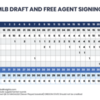Just curious, does everyone who is drafted, and this includes today or in the past, play at least a season of affiliated ball whether it be low A or summer penn league, etc.? What percentage of guys get drafted but never actually play a season for the affiliates of the team drafting or trading for them? Ie I was looking up a player who was drafted in the 33rd round a while ago, but there is no history of him ever playing ball other than independent leagues.
Replies sorted oldest to newest
Not all players sign. Some return for senior year. Some late picks move on with their lives. There’s a reason why the draft was shortened from sixty rounds to forty rounds and then to twenty. 94% of American MLBers come from the top twenty rounds.
Short season Low A was eliminated a couple of years ago. There is less opportunity.
If a players was drafted late when the draft was more than twenty rounds or signs as a free agent now it’s better if he’s a pitcher. A pitcher can change minds about his potential with velocity and spin rate. A position player who is a long shot doesn’t have much of a opportunity to show increased value.
@RJM posted:Not all players sign. Some return for senior year. Some late picks move on with their lives. There’s a reason why the draft was shortened from sixty rounds to forty rounds and then to twenty. 94% of American MLBers come from the top twenty rounds.
Short season Low A was eliminated a couple of years ago. There is less opportunity.
if a players was drafted late when the draft was more than twenty rounds or signs as a free agent now it’s better if he’s a pitcher. A pitcher can change minds about his potential with velocity and spin rate. A position player who is a long shot doesn’t have much of a opportunity to show increased value.
I guess the question, is really, does the draftee have a spot if he decides he wants it regardless of how bad the contract may be, or can the organization basically say, we drafted you but we don't have a spot for you.
@HSDad22 posted:I guess the question, is really, does the draftee have a spot if he decides he wants it regardless of how bad the contract may be, or can the organization basically say, we drafted you but we don't have a spot for you.
When I was drafted in the late forties the rule was if the MLB organization didn’t make contact in ten days I would have been a free agent. I was contacted on the fifth or sixth day. I obviously wasn’t that important. The draft was sixty rounds then.
A few years ago the draft was cut from forty to twenty rounds. I don’t know the current rule. But prospects need teammates. With only twenty rounds there are likely several free agents signings per team now.
@HSDad22 posted:I guess the question, is really, does the draftee have a spot if he decides he wants it regardless of how bad the contract may be, or can the organization basically say, we drafted you but we don't have a spot for you.
The mlb draft has 20 rounds and 614 slots. Each drafted player will receive an assigned slot which has a suggested amount assigned to it but is negotiable.
If a team and the player cannot come to terms, the player usually will return to school.
After the draft if a player hasn't been picked, has no college eligibility left, any team can sign him as a free agent, which is 120k (if I remember correctly).
All contracts are worded the same but may have addendums added, which would include money to complete school.
Not sure if I am 100% correct but thats basically how it works.
Son had a player in 2022 with 1 year left who was drafted by a team, turned down the offer went back to play one more year and get his degree. In 2023 he was drafted again, same team, better slot and $$$.
Hope that this answers your question.
All the info above is correct to my knowledge, I would just add the following.
Typically (2015-2017) my son’s involvement you know if you’re going to be drafted at any round. In 2015 (end of kid’s freshman juco year) he got a call after the 20th round and asked if he’d sign – he declined and wasn’t drafted. In 2016, his advisor was taking calls, but no offers that would stop him from going to Arkansas, in the 18th round he overslept, and Boston drafted him anyway, he did not sign He signed in 2017 in the 3rd round and things worked out – thankfully he didn’t head my advice in the process, he have taken that first offer…
For my son it worked out, but I know a couple kids that were drafted in HS, didn’t sign and were not drafted out of college – they both went to indy ball and never played affiliated ball.
Back when there were more draft slots, it wasn’t uncommon or a team to draft (late rounds), without calling a top prospect that chose college. The chances they’d sign was small, but things happen, and the team had the kid locked up that draft cycle. I don’t know the time limit is for getting someone to sign, but it’s way more than 10 days now. I don’t think they throw late draft picks away on low probability signs or kids of parents in the organization these days.
The other thing that might cause a fringe late draft pick to reconsider signing is that the signing bonus can be clawed back legally if you don’t stay your full contractual commitment. I’ve not heard if this happening, but I believe it’s part of every contract…
If I understand your question, you are asking if the team that drafts you can decline to place you on a minor league team. I think that they will certainly place you at least in the complex league for the remainder of your signing year; after spring training the following year, they will place you again, usually by age in A ball (college players to high A, high school players to low A), although highly ranked prospects may start in AA.
I think you have probably about two years in A ball to progress. I have seen one college player cut from low A by May of the year following the draft. That's unusual. Generally, if the team signs you, they will try to develop you for a few years. If you don't progress at all or go backward, player development can release you. And yes, a higher signing bonus indicates that a team will try to stick with you longer; if you sign for 1K, you are much easier to cut. I also believe you can voluntarily "retire," if the club agrees.
Was that the OP's question or am I on the wrong track here?
@JucoDad posted:All the info above is correct to my knowledge, I would just add the following.
Typically (2015-2017) my son’s involvement you know if you’re going to be drafted at any round. In 2015 (end of kid’s freshman juco year) he got a call after the 20th round and asked if he’d sign – he declined and wasn’t drafted. In 2016, his advisor was taking calls, but no offers that would stop him from going to Arkansas, in the 18th round he overslept, and Boston drafted him anyway, he did not sign He signed in 2017 in the 3rd round and things worked out – thankfully he didn’t head my advice in the process, he have taken that first offer…
For my son it worked out, but I know a couple kids that were drafted in HS, didn’t sign and were not drafted out of college – they both went to indy ball and never played affiliated ball.
Back when there were more draft slots, it wasn’t uncommon or a team to draft (late rounds), without calling a top prospect that chose college. The chances they’d sign was small, but things happen, and the team had the kid locked up that draft cycle. I don’t know the time limit is for getting someone to sign, but it’s way more than 10 days now. I don’t think they throw late draft picks away on low probability signs or kids of parents in the organization these days.
The other thing that might cause a fringe late draft pick to reconsider signing is that the signing bonus can be clawed back legally if you don’t stay your full contractual commitment. I’ve not heard if this happening, but I believe it’s part of every contract…
When the draft was in June players had until August 1 midnight to sign. One of my son’s travel teammates held out using college as leverage. He got within 200K of what he really wanted. He faxed back a copy of the signed contract at 11:58pm.
Back when I was drafted in the seventies the deadline wasn’t ten days. But, if the organization failed to make contact within ten days the player became a free agent. Being contacted and not signing without college eligibility remaining meant sitting out until the next draft. There were sixty rounds in the draft then. If a player isn’t contacted for ten days the organizational already has enough players lined up for short short season.
Sixty rounds is absurd. But, back then scouting wasn’t as scientific as it is now. It’s so scientific now twenty rounds and a few free agent signings is enough. All that was lost was the GMs son getting to brag he was drafted. He has to sign as a free agent now.
I think most of the process in general has been covered here.
As far as time frame to sign, I think it ends in July at some point.
Every player's journey is different. A lot of pitchers these days are shut down depending on the work load. There is instruction in fall also. Mine was drafted, sent to Penn league but then sent to facility in Jupiter for rehab because he was beat. He was drafted while practicing for regionals.
The 2023 baseball draft was July 9 to 11. The signing deadline was July 25 5pm. I’ll take a wild guess the signing deadline is fourteen days after the last day of the draft.
Last year at our regional, I met parents of a pitcher that just turned 21 as a sophmore. There is a name for that, I think they are called a "Super 2". Have no clue why. He got drafted and took the offer. The impression that I got was that the parents thought it would benefit him to stay one more year.
My point, there are all different things that can happen. It's up to the player to make the decision that's for him.
Attachments
I think I figured it out, drafted during JR year of college, went back to school and then was not drafted again.



